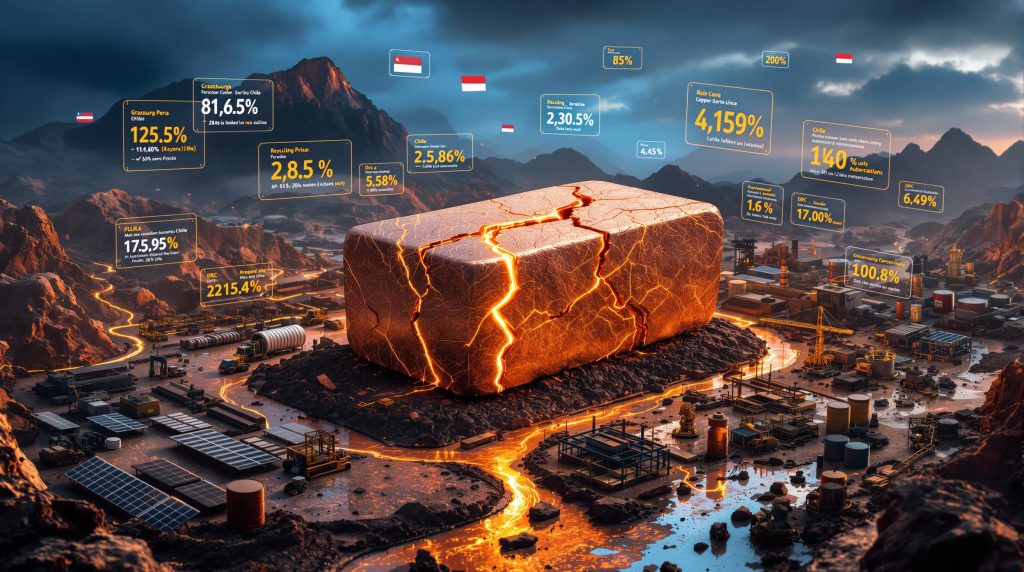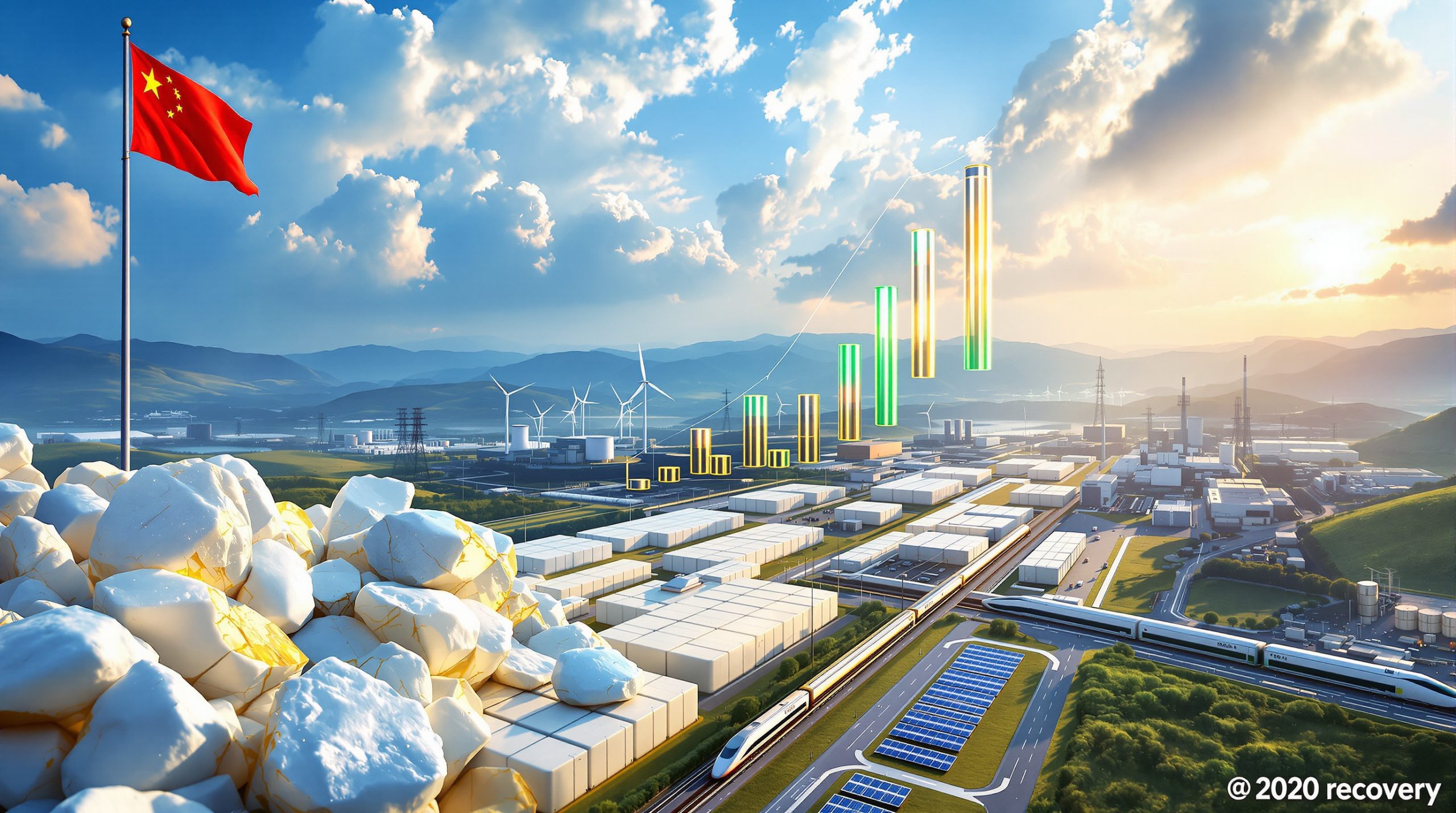Understanding the 2025 Copper Supply Disruption Crisis
The global copper market faces unprecedented challenges in 2025, with significant disruptions transforming what was projected as a modest surplus into a concerning deficit. This copper supply disruption threatens to extend through 2026, impacting industries worldwide and driving price volatility across commodity markets.
The Perfect Storm of Supply Constraints
Multiple factors have converged to create the current copper supply shortage. Operational accidents at major mining operations, escalating geopolitical tensions in key producing regions, and structural industry challenges have collectively destabilized the market. The combination of these elements has undermined previous copper price predictions that anticipated balanced market conditions in 2025.
The Grasberg Mine Incident: A Critical Blow to Global Supply
The most significant single event disrupting copper supply in 2025 has been the catastrophic incident at the Grasberg mine in Indonesia. As one of the world's largest copper operations, this disaster has severely impacted global copper supply forecast.
According to industry reports, the incident at Freeport-McMoRan's flagship operation has:
- Reduced global copper production by approximately 250,000-260,000 metric tons in 2025 alone
- Forced operational suspensions that may extend through multiple quarters
- Created logistical complications affecting concentrate shipments to smelters worldwide
- Triggered ripple effects throughout the processing and refining chain
The timing of this disruption proved particularly problematic as it coincided with several other supply constraints, effectively transforming market expectations from surplus to deficit within weeks.
Technical Assessment of Production Impact
Mining engineers familiar with the situation note that recovery operations will likely extend well into 2026. The technical complexity of restoring full operational capacity involves multiple phases of rehabilitation, safety assessments, and gradual production ramp-up.
How Geopolitical Tensions Are Affecting Copper Availability
Beyond specific mine incidents, copper supply faces mounting pressure from geopolitical tensions across major producing regions. These political factors have introduced additional uncertainty into an already constrained market.
Political Instability in Key Producing Regions
The copper supply chain remains vulnerable to disruptions in several critical mining jurisdictions:
- Peru: Community relations challenges have affected operations at several major mines, including significant production centers in the southern copper belt
- Chile: Political uncertainty surrounding mining legislation has created investment hesitancy across the sector
- Democratic Republic of Congo: Infrastructure limitations and governance challenges have constrained consistent production growth
These political factors collectively impact approximately 45% of global copper production capacity, creating an environment where minor disruptions can quickly escalate into significant supply shortfalls.
Rising Production Disruption Trend
Industry data shows a concerning upward trend in unplanned production disruptions:
| Year | % of Global Production Disrupted |
|---|---|
| 2014 | Under 5.0% |
| 2024 | 5.7% |
| 2025 | Over 6.0% (projected) |
This steady increase reflects growing vulnerability across the copper supply chain. Industry experts attribute this trend to several factors, including aging infrastructure at major operations, increasing technical challenges in accessing deeper ore bodies, and rising community expectations regarding environmental and social performance.
What Impact Has the Supply Disruption Had on Copper Prices?
The supply constraints have triggered significant price movements in copper markets, with both immediate reactions and longer-term repositioning by market participants.
Price Surge and Market Response
Copper futures have demonstrated notable volatility in response to the supply disruptions:
- Prices reached near two-month highs of approximately $4.75 per pound following news of the latest production setbacks
- Price volatility has increased significantly compared to historical averages
- Trading volumes have surged as market participants reposition in response to changing supply expectations
- Backwardation in futures markets has steepened, indicating near-term supply concerns
Bloomberg Intelligence analysis indicates that these price movements reflect genuine physical market tightness rather than purely speculative positioning. The reaction demonstrates the market's growing concern about copper availability through 2026.
Futures Market Positioning
Commodity trading patterns have shifted notably in response to the supply disruptions:
- Managed money net long positions in copper futures have increased to approximately 20% of total open interest
- This represents the highest speculative positioning in over a year
- The rapid accumulation of long positions indicates growing concern about future availability
- The potential for position unwinding creates additional price risk if market sentiment shifts
These trading patterns highlight the market's struggle to price in both immediate supply disruptions and their longer-term implications for industrial consumers. Additionally, the tariff impact on copper has further complicated market dynamics.
How Are Structural Supply Chain Challenges Compounding the Problem?
The copper industry faces several structural challenges that extend well beyond specific mine incidents. These systemic issues create a multiplier effect when combined with acute disruptions.
Beyond Mine Disruptions: Systemic Challenges
Industry-wide constraints affecting copper supply include:
- Raw Material Constraints: Critical inputs like sulfuric acid and processing chemicals face their own supply challenges
- Equipment Availability: Lead times for specialized mining equipment have extended significantly, delaying capacity expansions
- Environmental Regulations: Permitting timelines have lengthened in most major mining jurisdictions
- Energy Volatility: Power supply reliability issues affect production stability in several key regions
- Labor Shortages: The mining sector faces growing skills gaps, particularly in specialized technical roles
The Infrastructure Bottleneck
Transport and processing infrastructure limitations further complicate the supply picture:
- Port capacity constraints in key export regions create logistical bottlenecks
- Rail transportation limitations affect concentrate movement in several producing countries
- Smelter capacity hasn't kept pace with mining expansion in many regions
- Water availability challenges affect processing operations in arid mining regions
These infrastructure limitations mean that even when mines operate at full capacity, getting material to market remains challenging.
What Does This Mean for Industries Dependent on Copper?
The copper supply disruption creates significant challenges for industries that rely on steady copper availability. Different sectors face varying levels of exposure and have implemented different mitigation strategies.
Downstream Impact on Critical Sectors
Several key industries face particular challenges from copper supply constraints:
- Renewable Energy: Solar and wind projects require substantial copper inputs, with potential timeline impacts from material availability challenges
- Electric Vehicle Manufacturing: A typical EV contains 2-4 times more copper than conventional vehicles, making production targets vulnerable to supply disruptions
- Construction: Electrical wiring and plumbing components face potential constraints, affecting building project timelines
- Electronics: Consumer electronics manufacturers may face component shortages or cost increases
According to the International Copper Association, construction accounts for approximately 65% of global copper consumption, with electrical and electronic products representing about 20%, and transportation, including EVs, accounting for roughly 10%.
Strategic Responses from Manufacturers
Companies across these sectors have implemented various strategies to address copper supply challenges:
- Forward purchasing to secure supply availability
- Materials engineering to reduce copper intensity where technically feasible
- Increased recycling initiatives to recover more copper from existing products
- Supply chain diversification to reduce dependency on specific mining regions
- Inventory management adjustments to provide additional buffer against disruptions
These strategies reflect growing recognition that copper supply challenges may represent a longer-term structural issue rather than a temporary disruption, particularly with surging copper demand from emerging sectors.
How Are Mining Companies Responding to the Supply Challenges?
Major copper producers have implemented various strategies to address the supply shortfall, focusing on both immediate mitigation and longer-term capacity expansion.
Strategic Adjustments in the Mining Sector
Leading copper mining companies are pursuing multiple approaches:
- Accelerating Expansion Projects: Fast-tracking planned capacity increases where technically feasible
- Operational Optimization: Enhancing recovery rates and reducing processing losses at existing operations
- Exploration Investment: Increasing funding for new deposit identification and resource definition
- Technology Deployment: Implementing advanced technologies to improve extraction efficiency
- Risk Management: Diversifying operations across multiple geographies to reduce concentration risk
Mining industry executives acknowledge that while these strategies can help mitigate the current supply constraints, many solutions require multi-year implementation timeframes.
Investment Challenge
The scale of investment required presents its own challenge:
- Industry analysts estimate the copper sector needs approximately $100-150 billion in new mine development to meet projected 2030 demand
- Current investment rates fall significantly below this requirement
- Capital allocation decisions face additional complexity from rising development costs and extended permitting timelines
- The industry must balance immediate operational needs against long-term capacity development
These investment dynamics suggest that even with aggressive capital deployment, supply constraints could persist through much of this decade. In fact, recent copper investment insights highlight this ongoing challenge.
What Role Does Copper Recycling Play in Addressing Supply Shortages?
As primary production faces constraints, recycling has gained increased attention as a potential mitigation strategy. Secondary copper sources provide an increasingly important supplementary supply stream.
The Growing Importance of Secondary Supply
Recycling offers several advantages in addressing supply constraints:
- Current global copper recycling rates average approximately 30-35%, according to the International Copper Study Group
- Recycled copper accounts for about 8.5 million tonnes annually of the total 30+ million tonnes of copper consumed globally
- Secondary production typically requires 85-90% less energy than primary production
- Copper can be recycled indefinitely without loss of performance properties
Industry initiatives aim to increase recycling rates to over 40% by 2030, potentially providing a meaningful offset to primary production challenges.
Urban Mining Potential
The concept of "urban mining" – recovering copper from existing infrastructure and products – represents a growing opportunity:
- Global urban copper stocks exceed 400 million tonnes, representing decades of potential supply
- Technological advances are improving the economics of processing complex waste streams
- Policy initiatives in several regions are strengthening incentives for metal recovery
- Collection system improvements are increasing capture rates for end-of-life products
While these secondary sources cannot completely replace primary production, they provide an increasingly important supply supplement that helps moderate price volatility.
How Does the 2025 Copper Market Balance Compare to Previous Supply Disruptions?
The 2025 copper supply disruption differs from previous shortages in several key aspects, suggesting potentially more prolonged market impacts.
Historical Context for Current Challenges
Several factors distinguish the current situation from past disruptions:
- Scale of Disruption: The combination of multiple simultaneous disruptions represents one of the largest supply shocks in decades
- Demand Context: Unlike previous disruptions, this occurs amid accelerating demand from energy transition sectors
- Inventory Levels: Global copper inventories entered 2025 at relatively low levels, providing limited buffer
- Market Structure: Greater financialization of copper markets has amplified price responses to physical shortages
These factors suggest the current disruption may have more prolonged effects than historical precedents, potentially extending well into 2026. As reported by Reuters, major financial institutions have already downgraded their copper supply forecasts following the Grasberg incident.
Market Memory and Response Patterns
Historical market responses to major disruptions provide some context:
- Previous significant disruptions typically resolved within 6-12 months as alternative supply sources increased production
- Price spikes during past disruptions averaged 25-30% before moderating as the market rebalanced
- Producer hedging patterns have evolved, potentially changing market response dynamics
- Consumer inventory management has become more sophisticated, but just-in-time supply chains remain vulnerable
These historical patterns suggest that while markets eventually rebalance, the adjustment period can create significant challenges for unprepared consumers.
What Are the Long-Term Implications for Copper Supply Security?
The 2025 disruptions highlight several long-term considerations for copper supply security that extend well beyond the immediate market impacts.
Future Outlook and Strategic Considerations
Several fundamental factors will shape copper availability through this decade:
- Investment Requirements: The industry needs approximately $100-150 billion in new mine development to meet projected 2030 demand
- Project Timelines: New copper mines typically require 7-10 years from discovery to production
- Resource Nationalism: Growing tendency for producer countries to seek greater economic benefits from their resources
- Technological Innovation: Potential for breakthrough technologies to unlock previously uneconomic resources
These factors suggest that while the current disruption will eventually resolve, the copper market may experience structural tightness for much of the coming decade without significant investment acceleration.
The Ore Grade Challenge
Declining ore grades present a particular challenge for future supply:
- Average copper grades have declined from approximately 1.2% in the 1990s to below 0.7% today
- Lower grades require more energy, water and processing capacity per ton of copper produced
- Environmental footprints increase inversely with grade reductions
- Economic viability becomes more sensitive to price fluctuations at lower grades
This fundamental challenge means that even with significant investment, production costs are likely to trend upward over time. According to Trading Economics data, this underlying cost pressure is already reflected in long-term price trends.
Navigating the Copper Supply Challenge
The 2025 copper supply disruption represents a complex convergence of specific incidents, geopolitical tensions, and structural industry challenges. This disruption has transformed what was already a tight market into one facing significant deficit conditions.
For industries dependent on copper, this environment requires strategic planning, supply chain diversification, and potentially accelerated innovation in material efficiency. For producers, it highlights the critical importance of operational risk management and geographic diversification.
As the global economy continues its transition toward electrification and renewable energy, ensuring adequate copper supply remains a critical challenge that will require coordinated efforts across mining companies, technology sectors, and policy domains.
Key Monitoring Indicators
Market participants should watch several indicators to gauge the evolution of this supply situation:
- Exchange inventory levels, particularly the rate of change
- Treatment and refining charges for copper concentrates
- Price spreads between immediate and future delivery months
- Producer hedging activity and forward selling patterns
- Recycling rate changes and secondary market premiums
These indicators will provide early signals of whether supply constraints are easing or intensifying as we move through 2025-2026.
Disclaimer: This analysis represents current market conditions as of September 2025. Supply situations can evolve rapidly, and readers should consult updated sources before making business or investment decisions related to copper markets.
Ready to Profit from the Next Major Copper Discovery?
Stay ahead of the copper market with Discovery Alert's real-time notifications on significant ASX mineral discoveries, powered by the proprietary Discovery IQ model. Explore why major mineral discoveries can lead to substantial returns by visiting Discovery Alert's dedicated discoveries page and begin your 30-day free trial today.




